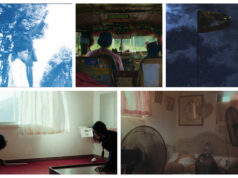Ramon Santos: A much-needed boost for contemporary music
Ramon P. Santos and Francisco F. Feliciano, National Artists for Music.
Words Pablo A. Tariman

With the proclamation of composers Ramon Santos and Francisco Feliciano as National Artists for Music, contemporary music in the country has received a much needed shot in the arm.
The conferment of the honor on the two should open the eyes of music lovers to the fact that there is life and excitement outside conventional classical music and perhaps lead them towards a greater appreciation of their rarely performed pieces. It is, after all, much more challenging to listen to contemporary music.
The two share many things in common aside from the fact that both were honored by their country this year. They were both born in 1941 in the province of Rizal (Santos was born in Pasig, Feliciano in Morong), they both studied abroad (Feliciano at the Berliner Kirchenmusikschule, earning a diploma in music composition at the Hochchule der Kunste in Berlin, and a Doctor in Musical Arts from Yale; Santos earning doctorate degrees from Indiana University and State University of New York), and both have a fascination with indigenous musical forms and instruments which are reflected in their works.
Santos’s work was last heard at the Cultural Center of the Philippines last year when a cultural group from Albay presented his ballet, Daragang Magayon, based on the Bicol legend behind Mayon Volcano.
In the early 1980s, Feliciano’s grand entrance into Manila’s music world was through his opera, La Loba Negra, with a libretto by soprano Fides Cuyugan Asencio—it was one of the few times when contemporary music ruled Manila’s opera scene which is normally inundated by the works of Verdi and Puccini.
While it is true that Feliciano was most familiar to the country’s music audiences thanks to his stint as conductor of the Philippine Philharmonic Orchestra, it is equally true that as a composer he has a body of work the country can be proud of.
Music critic Antonio Hila assesses Feliciano’s works in music theater thus:
“Bringing out indigenous culture through music is evident in Feliciano’s opera La Loba Negra, in Ashen Wings, in the musical theater piece Sikhay sa Kabila ng Paalam, and in the ballet music of Yerma.
“In these works, he brings out Filipino mysticism in simple harmonies that captivate and charm the listener. Disclosing ideas in their simplest state is a master stroke that has produced a haunting and lasting impact on audiences.
After 30 years, the times have finally caught up with the two composers. As Hila notes: ‘Their works have found a place in concert programs, either instrumental or choral.’
“La Loba Negra, for instance, employs the pasyon in the introductory part. In one of its productions, it featured the pasyon singers from Feliciano’s hometown. The moving concluding chorus, ‘Sisikat ang Araw,’ utilizes the ever-popuar kundiman ‘Bayan Ko.’”
Santos, meanwhile, explored the aesthetic frameworks of Philippine and Southeast Asian artistic traditions and came up with versatile uses of the country’s indigenous instruments.
While he respected the Philippines’ Western musical heritage, he spent a lifetime in the field studying traditional music such as the musical repertoires of the Ibaloi, the Mansaka, Bontoc, Yakan and Boholano.
His areas of relentless concern, aside from the above cultural communities, also include Philippine art music and contemporary music, and selected music from Southeast Asia and the cultural communities of South China.
While the majority of his countrymen were preoccupied with pop music and a small but influential sector propagated Western classical music, Santos zeroed in on Philippine contemporary classic music and became a distinguished though relatively unheralded composer. After 30 years, the times have finally caught up with the two composers. As Hila notes: “Their works have found a place in concert programs, either instrumental or choral.” To sustain this interest, Hila suggests that the education department should include Philippine music in the curriculum.
“Ironically, some teachers would not even know Tita King (Lucrecia Kasilag) or Antonino Buenaventura, because the cultural diet has been neglected in the schools, and even the broadcast media,” he said, noting that the last time culture— particularly music—got a boost was during the Marcos era.
“After [the Marcoses], the arts [became the] last priority and even the choice of National Artists has become controversial.” he said. “Truly, it is ironic for a Third World country to relegate culture and the arts to the margins when culture and the arts are potent partners for national development.”
It would be useful, he noted, if the country’s national orchestras gave Western music a rest and started featuring the landmark works by Feliciano and Santos in their regular concert seasons.
“If any orchestra can open with a Western overture like Beethoven’s, which had been played over and over again, why can’t local orchestras include works of said composers? Santos’ L’Bad for large orchestra is a good example as well as Time-Space for two orchestras, etc. Feliciano’s Transfiguration, prelude and toccata can also take over for some overplayed Western overtures.”
Disregarded by President Gloria Arroyo in favor of film embarrassment Carlo J. Caparas, Santos indeed deserved to be National Artist.
“Santos spearheaded programs to promote new perspectives about Asian and Filipino life and culture by organizing international rondalla festivals and composers’ forum on traditional music,” he pointed out. “[Santos] rediscovered and showcased Philippine cultural traditions and, most of all, his compositions are ground-breaking, espousing Asianization of Philippine art through integration and use of mixed media, such as music, dance, theater, poetry, visuals, incorporating as well ideas about nature and the metaphysical universe.
“On the whole, Santos succeeded in recreating Philippine traditional music in modern forms of expression.”
Santos and Feliciano, both champions of truly original Filipino music, have finally gotten what they deserve.
Sidebar | The ‘strange-sounding’ music of Ramon Santos
Learning a Ramon Santos piece is like tottering tip-toed on an uneven staircase. The avant-garde composer challenges even the most professionally trained musicians with melodic structures that are asymmetrical and unpredictable. He is unafraid of using minor keys—dark and melancholy—for children’s songs. The first chord in “Sampung mga daliri,” the opening song in a madrigal piece titled “Tuksuhan,” is a D diminished, a dissonant triad described by music aficionados as “strange-sounding.”
Who else but Mr. Santos would use a strange-sounding chord for a children’s song? The beginning sets the tone of the rest of the piece, which goes on to use more of these chords. It is these uncommon musical choices that made him National Artist. “Composition is invention,” he said, “It’s creation. It’s not imitation. When you compose, you have to create something new. You have to create a new expression.”
Madrigal singing, a secular vocal music style, is traditionally an unaccompanied polyphony, or two or more simultaneous lines of independent melody. Locally, the style received exposure because of the Philippine Madrigal Singers, for whom Mr. Santos composed “Tuksuhan” and “Tula-tula,” the first madrigal choir pieces to join a previously Western-limited repertoire. “I was the first to do that,” he said. “The other [Filipino] composers followed suit.”

A choir boy in his youth, Mr. Santos was exposed to the harmonies of liturgical music as a high school student at the San Jose Seminary. After entering the University of the Philippines College of Music, he discovered Jose Maceda, an ethnomusicologist whose Asian impulses had a big influence on Mr. Santos. “My music shifted to different concepts in Asian music,” he said, “I wrote rituals, pieces for hundreds of performers, and music for non-traditional instruments.” His experimental pieces include “Ding Ding Nga Diyawa,” which uses the timpani, agung, and kulintang.
During his studies in the United States, he expanded his horizons with the prevailing styles of modern music from the traditions of China, Indonesia, and Northern and Southern Philippines. He integrates sound with other art forms in “Siklo,” which portrayed the cycle of life with a choreography of amoeba-like movements, and Daragang Magayon, a full-length ballet he first wrote in the 1990s and then revisited a few years ago for the rondalla. Prior to Daragang Magayon, there has never been a full-length ballet written for the Spanish ensemble of stringed instruments.
“Filipino musicians are very talented. However, many of us merely imitate—sayang,” he lamented in the vernacular. “We are very creative people. First of all, our culture is diffused. We know the West, we know Asia. But it is our Asian heritage that we don’t develop, though we are very, very rich—150 language groups. All of that with various types of music.” There is still much to learn and to this day, Mr. Santos goes to the mountains to do research. “That is where our soul is, he said, “not the West.” — Pola Esguerra del Monte



